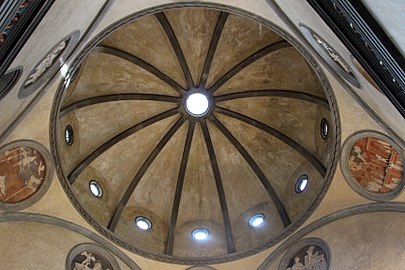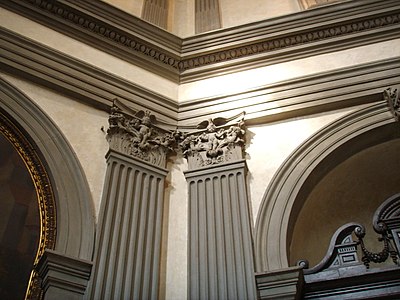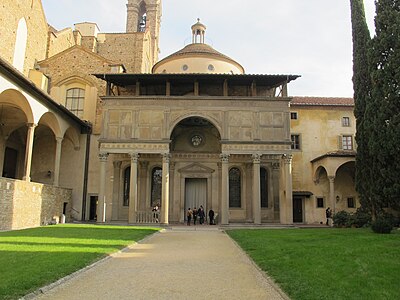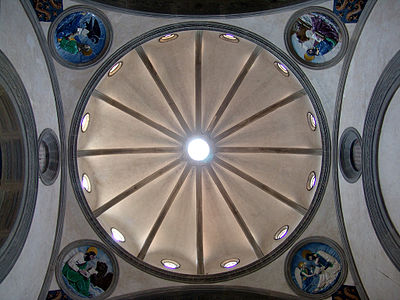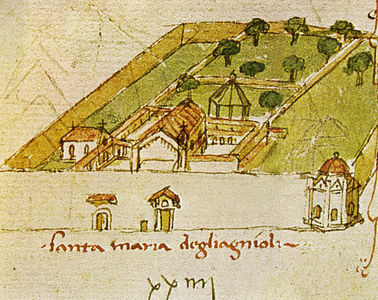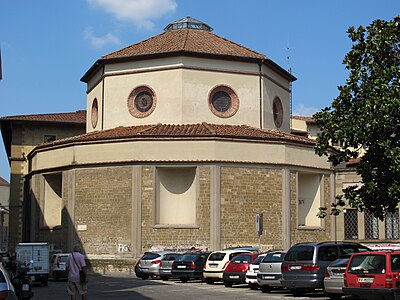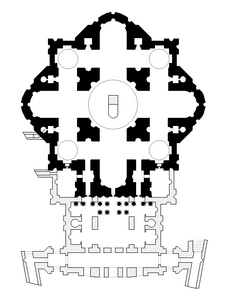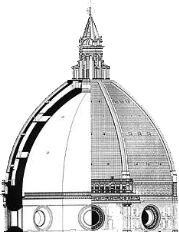Filippo Brunelleschi
Filippo Brunelleschi | |
|---|---|
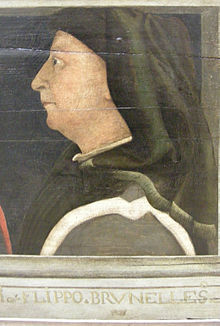 Anonymous portrait from the 2nd half of the 15th century (Louvre, Paris) | |
| Born | Filippo di ser Brunellesco di Lippo Lapi[1] 1377 |
| Died | 15 April 1446 (aged 68–69) Florence, Republic of Florence |
| Known for | Architecture, sculpture, mechanical engineering |
| Notable work | Dome of Santa Maria del Fiore |
| Movement | Early Renaissance |

Filippo di ser Brunellesco di Lippo Lapi (1377 – 15 April 1446), commonly known as Filippo Brunelleschi (/ˌbruːnəˈlɛski/ BROO-nə-LESK-ee; Italian: [fiˈlippo brunelˈleski]) and also nicknamed Pippo by Leon Battista Alberti,[4] was an Italian architect, designer, goldsmith and sculptor. He is considered to be a founding father of Renaissance architecture. He is recognized as the first modern engineer, planner, and sole construction supervisor.[5][6] In 1421, Brunelleschi became the first person to receive a patent in the Western world.[7][8] He is most famous for designing the dome of the Florence Cathedral, and for the mathematical technique of linear perspective in art which governed pictorial depictions of space until the late 19th century and influenced the rise of modern science.[9][10] His accomplishments also include other architectural works, sculpture, mathematics, engineering, and ship design.[6] Most surviving works can be found in Florence.
Biography
[edit]Early life
[edit]Brunelleschi was born in Florence, Italy, in 1377.[11] His father was Brunellesco di Lippo (born c. 1331),[1] a notary and civil servant. His mother was Giuliana Spini; he had two brothers.[12] The family was well-off; the palace of the Spini family still exists, across from the Church of the Trinità in Florence.[13] The young Filippo was given a literary and mathematical education to enable him to follow the father's career. Being artistically inclined, however, Filippo, at the age of fifteen, was apprenticed at the Arte della Seta, the wool merchants' guild, the wealthiest and most prestigious guild in the city, which also included jewellers and metal craftsmen. In December 1398, he became a master goldsmith and a sculptor working with cast bronze.[6][14]
Sculpture – Competition for the Florence Baptistry doors
[edit]Brunelleschi's earliest surviving sculptures are two small bronze statues of evangelists and saints (1399–1400) made for the altar of the Crucifix Chapel Pistoia Cathedral.[15] He paused this project in 1400, when he was chosen to simultaneously serve two representative councils of the Florentine government for about four months.[16]
Around the end of 1400, the city of Florence decided to create new sculpted and gilded bronze doors for the Florence Baptistery.[17][a] A competition was held in 1401 for the design, which drew seven competitors, including Brunelleschi and another young sculptor, Lorenzo Ghiberti. Each sculptor had to produce a single bronze panel, depicting the Sacrifice of Isaac within a Gothic four-leaf frame. The panels each contained Abraham, Isaac, an angel and other figures imagined by the artists, and had to harmonize in style with the existing doors, produced in 1330 by Andrea Pisano. The head of the jury was Giovanni di Bicci de' Medici, who later became an important patron of Brunelleschi. The jury initially praised Ghiberti's panel. When they saw Brunelleschi's work, they were unable to choose between the two and suggested that the two artists collaborate on the project.[18] Brunelleschi refused to forfeit total control of the project, preferring it to be awarded to Ghiberti. This divided public opinion.[18]
Brunelleschi would eventually abandon sculpture and devote his attention entirely to architecture and optics,[19] but continued to receive sculpture commissions until at least 1416.[20]
-
St. John the Evangelist, Altar of Saint at Church of San Zeno, Pistoia (1399–1400)
-
Prophet Jeremiah detail of altarpiece, Church of San Zeno, Pistoia (1399–1400)
-
The Prophet Isaiah, Church of San Zeno, Pistoia detail of altarpiece (1399–1400)
-
The Sacrifice of Isaac, Brunelleschi's competition project for a door panel of the Baptistry of Florence (1401)
Rediscovery of antiquity (1402–1404)
[edit]During the Early Renaissance, there was a growing interest in ancient Greek and Roman art compared to medieval art, which was largely dominated by Byzantine art. Initially this cultural interest was borne by a few scholars, writers, and philosophers. It later became more influential across the visual arts.[citation needed] In this period (1402–1404),[21] Brunelleschi visited Rome, almost certainly accompanied by his younger friend, the sculptor Donatello, to study its ancient ruins.[22] Donatello may have been trained as a goldsmith, like Brunelleschi, and later worked in the studio of Ghiberti. Although the glories of Ancient Rome were a matter of popular discourse at the time, few people had actually studied the physical conditions of its ruins in any detail until Brunelleschi and Donatello did so. Brunelleschi's study of classical Roman architecture influenced his building designs including even lighting, the minimization of distinct architectural elements within a building, and the balancing of those elements to homogenize the space.[23]
It has been speculated that Brunelleschi developed his system of linear perspective after observing the Roman ruins.[20] However, some historians dispute that he visited Rome then, given the number of projects Brunelleschi had in Florence at the time, the poverty and lack of security in Rome during that period, and the lack of evidence of the visit.[24][page needed] His first definitively documented visit to Rome was in 1432.
The Foundling Hospital (1419–1445)
[edit]
Brunelleschi's first architectural commission was the Ospedale degli Innocenti (1419–c. 1445), or Foundling Hospital, designed as a home for orphans. The Guild of the Silk Merchants' Guild owned, funded and managed the hospital.[26] As with many of Brunelleschi's architectural projects, the building was completed after a significant time lapse and with considerable modifications by other architects. He was the official architect until 1427, but he was rarely on site after 1423. The hospital was completed by the Florentine architect Francesco della Luna in 1445.[27][28]
The major portion completed by Brunelleschi was an arcade or loggia with nine arches, supported on each side by pilasters, which gave the appearance of columns, and opening to the interior by a small door. The arcade was supported by slender columns with Corinthian capitals. This first arcade, with its columns, rounded arches and simple classical decoration, became an established model for numerous Renaissance buildings across Europe.[27] Its long loggia and the 8m high arches were an outstanding sight along the narrow and bending streets of Florence. The building's style was dignified and sober, with no displays of fine marble or decorative inlays.[29] It was also the first building in Florence to make clear reference—in its columns and capitals—to classical antiquity.
-
Cloister of Men of the Foundling Hospital (1419–1445)
-
Arcade of the Foundling Hospital (1419–1445)
-
Corinthian column in the cloister
Thereafter Brunelleschi was awarded additional commissions, like the Ridolfi Chapel in the church of San Jacopo sopr'Arno (not surviving), and the Barbadori Chapel in Santa Felicita (since modified). In both projects Brunelleschi devised elements already used in the Ospedale degli Innocenti, and which would also be used in the Pazzi Chapel and the Sagrestia Vecchia. He was using these relatively small projects to pilot ideas which he would later employ in his most famous work, the dome of the Cathedral of Florence.
Basilica of San Lorenzo (1421–1442)
[edit]Brunelleschi undertook the major project of the Basilica of San Lorenzo soon after he had begun the Foundling Hospital. The Basilica was the largest church in Florence, sponsored by the Medici family (the church hosted the family's mausoleum). Numerous architects worked at the church, including, later, Michelangelo. Brunelleschi designed the central nave, with the two collateral naves on either side lined by small chapels, and the old sacristy.
The first stage of the project was the Old Sacristy, built between 1419 and 1429. It contains the tomb of Giovanni di Bicci de' Medici and his wife, beneath a central dome, simply decorated. The chapel is a cube of about 11 metres (36 feet) on each side, covered with a hemispheric dome. A level of ornamental entablements divides the vertical space into two parts, and pilasters support the dome. The altar is set into a recess at one end beneath a smaller dome. All of the arcs of the ceiling are supported by pilasters, like classical columns, set into the walls. This room, using classical elements in an innovative way, established itself as a standard in Renaissance interior architecture.[30]
Along the nave, slender columns with Corinthian capitals replaced the massive pillars of Gothic architecture. A coffered ceiling of square compartments with delicately gilded trim replaced the traditional vaulted ceiling of the central nave. Circular windows above each chapel were introduced to bridge the difference in height between the low chapels and the much higher nave. The new interior projected an impression of harmony and balance.[31]
Brunelleschi used white walls in the Old Sacristy, which later became a common element of Renaissance architecture. Leon Battista Alberti (who wrote in 1450 the standard text of Renaissance art) argued that, since classical times, according to prominent authors like Cicero and Plato, white was the only color suitable for a temple or church and praised "the purity and simplicity of the color, like that of life."[32]
-
Nave of the Basilica of San Lorenzo (1425–1442)
-
View of the Old Sacristy
-
Vault of the Old Sacristy (Sagrestia vecchia)
-
Doorway with a classical pediment and columns, framed by pilasters
-
Sky of Florence decoration by Giuliano d'Arrigo on the small dome in the Old Sacristy (1442)
Basilica of Santo Spirito (1434–1466)
[edit]The Basilica of Santo Spirito in Florence was his next major project, which, characteristically, he carried out in parallel with his other major works. Though he began designing in 1434, construction did not begin until 1436, and continued beyond his lifetime. The columns for the facade were not delivered until 1446, ten days before his death, and the facade was not completed until 1482, and then was modified in the 18th century. The bell tower was also a later addition.[33]
Santo Spirito is an example of the mathematical proportion and harmony of Brunelleschi's work. The church is in the form of a cross. The choir, the two arms of the transept, and the space in the center of the transept are composed of squares exactly the same size. The continuation of the nave contains four more identical squares. and a half-square (a later addition) at the end. The length of the transept is exactly one-one half of the length of the nave. Each square of the lower collateral naves is one-quarter the size of the squares in the principal nave. The collateral naves are lined with thirty-eight small chapels, which were later filled with altars decorated with works of art.[33]
The vertical plan is also perfectly in proportion; the height of the central nave is exactly twice its width, and the height of the collateral naves on either side are exactly twice their width. Other aspects of his original plan, however, were modified after his death. The main aisle of the nave, lined by columns with Corinthian capitals, is topped by a row of semicircular arches, like his galleries. His original plan called the ceiling of the nave to be composed of a barrel vault, which would have echoed the collateral naves, but this was also changed after his death to the flat coffered ceiling. Little remains of the exterior walls that he had planned. They were unfinished at his death and were covered with a facade in a different style in the Baroque period.[33]
-
Central nave of Santo Spirito
-
The dome of Santo Spirito
-
Brunelleschi's plan of Santo Spirito
-
Detail of the classical pilasters of the Sacristy
Pazzi Chapel (1430–1444)
[edit]The Pazzi Chapel in Florence was commissioned in about 1429 by Andrea Pazzi to serve as the Chapter House, or meeting place of the monks of the Monastery of Santa Croce. Like nearly all of his works, the actual construction was delayed, beginning only in 1442, and the interior was not finished until 1444. The building was not entirely finished until about 1469, twenty years after his death. Some of the details, such as the lantern on top of the dome, were added after his death.[34]
The portico of the chapel is especially notable for its fine proportions, simplicity, and harmony. Its centerpiece is a sort of arch of triumph. Its six columns are by an entablature sculpted medallions, an upper level divided by pilasters and a central arch, and another band of sculpted entablature the top, below a terrace and the simple cupola. The interior spaces are framed by arches, entablatures, and pilasters. The floor is also divided into geometric sections. Light comes downward from the circular windows of the dome, and changes throughout the day. The interior is given touches of color by circular blue and white ceramic plaques made by the sculptor Luca Della Robbia. The architecture of the chapel is based on an arrangement of rectangles, rather than squares, which makes it appear slightly less balanced than his chapel in the Old Sacristy of San Lorenzo.[34]
-
Facade of the Pazzi Chapel
-
Plan of the Pazzi Chapel
-
Dome of the Pazzi Chapel
-
Interior of the Pazzi Chapel with sculptural plaques by Luca Della Robbia
Santa Maria degli Angeli (1434–1437)
[edit]Santa Maria degli Angeli was an unfinished project by Brunelleschi which introduced a revolutionary concept in Renaissance architecture. Churches since the Romanesque and Gothic periods were traditionally in the form of a cross, with the altar in the transept or crossing point. Santa Maria deli Angeli was designed as a rotunda in an octagon shape, with eight equal sides, each containing a chapel, and the altar in the center.
The financing of the church came from the legacy of two Florentine merchants, Matteo and Andrea Scolari, and construction commenced in 1434. However, in 1437, the money for the church was seized by the Florentine government to help finance a war against the neighboring city of Lucca. The structure, which had reached a height of 7 m (23 ft), was never completed as Brunelleschi designed it. The completed part was later integrated into a later church of a different design.[35]
The plans and model of Brunelleschi's church disappeared, and it is known only from an illustration in the Codex Rustichi from 1450, and from drawings of other architects. Leon Battista Alberti, in his De re aedificatoria, the first major treatise on Renaissance architecture, written in about 1455 and published in 1485, hailed the design as the "first complete plan of a Renaissance church." Leonardo da Vinci visited Florence in about 1490, studied Brunelleschi's churches and plans, and sketched a plan for a similar octagonal church with radiating chapels in his notebooks. It reached its fruition on an even larger scale in the 16th century. Donato Bramante proposed a similar central plan with radiating chapels for his Tempieto, and later, on an even larger scale, in his plan for Saint Peter's Basilica (1485–1514).[36] The central plan was finally realized, with some modifications, beginning in 1547, in Saint Peter's by Michelangelo and then its completed version by Carlo Maderna.[37]
-
1450 Codex Rustici drawing showing Brunelleschi's proposed octagonal church (lower right)
-
Plan of the rotunda of Santa Maria degli Angeli
-
Brunelleschi's rotunda from Santa Maria degli Angeli. Only the lower wall remains of his original design.
-
Michelangelo's plan for Saint Peter's Basilica, Rome (1546), superimposed on the earlier plan by Bramante
Florence Cathedral dome (1420–1461)
[edit]Santa Maria del Fiore was the cathedral and symbol of Florence, which had been begun in 1296. After the death of the first architect, Arnolfo di Cambio, work was interrupted for fifty years. The campanile, or bell tower, was added by Giotto soon after 1330. Between 1334 and 1366 a committee of architects and painters made a plan of a proposed dome, and the constructors were sworn to follow the plan. The proposed dome from the base to the lantern on top was more than 80 m (260 ft) high, and the octagonal base was almost 42 m (138 ft) in diameter. It was larger than the dome of the ancient Pantheon, or any other dome in Europe, and no dome of that size had been built since antiquity.[38]
A competition was held in 1418 to select the builder, and other competitors included his old rival Ghiberti. It was won by Brunelleschi, with the help of a brick scale model of the dome made for him by his friend the sculptor Donatello.[38] Since buttresses were forbidden by the city fathers, and because obtaining rafters for scaffolding long and strong enough (and in sufficient quantity) for the task was impossible, how a dome of that size could be constructed without its collapsing under its own weight was unclear. Furthermore, the stresses of compression were not clearly understood, and the mortars used in the period would set only after several days, keeping the strain on the scaffolding for a long time.[39]
The work on the dome (built 1420–1436), the lantern (built 1446–c. 1461) and the exedra (built 1439–1445) occupied most of the remainder of Brunelleschi's life.[40] Brunelleschi's success can be attributed to his technical and mathematical genius.[41] Brunelleschi used more than four million bricks in the construction of the octagonal dome. Notably, Brunelleschi left behind no building plans or diagrams detailing the dome's structure; scholars surmise that he constructed the dome as though it were hemispherical, which would have allowed the dome to support itself.[42]
Brunelleschi constructed two domes, one within the other, a practice that would later be followed by all the successive major domes, including those of Les Invalides in Paris and the United States Capitol in Washington. The outer dome protected the inner dome from the rain and allowed a higher and more majestic form. The frame of the dome is composed of twenty-eight horizontal and vertical marble ribs, or eperoni, eight of which are visible on the outside. Those visible on the outside are largely decorative, since the outer dome is supported by the structure of the inner dome. A narrow stairway runs upward between the two domes to the lantern on the top.[38] Older examples of double-shelled domes include the 50m tall Dome of Soltaniyeh and the Mausoleum of Khoja Ahmed Yasawi.
Brunelleschi invented a new hoisting machine for raising the masonry needed for the dome, a task no doubt inspired by republication of Vitruvius' De architectura, which describes Roman machines used in the first century AD to build large structures such as the Pantheon and the Baths of Diocletian, structures still standing, which he would have seen for himself. This hoisting machine would be admired by Leonardo da Vinci years later.[43]
The strength of the dome was improved by the wooden and sandstone chains invented by Brunelleschi, which acted like tensioning rings around the base of the dome and reduced the need for flying buttresses, so popular in Gothic architecture.[44] The herringbone brick-laying pattern, which Brunelleschi may have seen in Rome, was also seemingly forgotten in Europe before the construction of the dome.[45]
Brunelleschi kept his workers up in the building during their breaks and brought food and diluted wine, similar to that given to pregnant women at the time, up to them. He felt the trip up and down the hundreds of stairs would exhaust them and reduce their productivity.[46]
Once the dome was completed, a new competition was held in 1436 for the decorative lantern on top of the dome, once again against his old rival Ghiberti. Brunelleschi won the competition and designed the structure and built the base for the lantern, but he did not live long enough to see its final installation atop the dome.[47]
In 1438 Brunelleschi designed his last contribution to the cathedral; four hemispherical exedra, or small half-domes, based on a Roman model, set against the drum at the base of the main dome. They alternated the four small domes arranged around the main dome and gave the appearance of a stairway of domes mounting upward. They were purely decorative and were richly decorated with horizontal entablatures and vertical arches, pilasters, and double columns. Even though decoration was the forefront of motivation for the design. The technological advancements of gunpowder and portable cannons required a new system of fortification which led to further development of the double shelled dome.[48] Their architectural elements inspired later High Renaissance architecture, including the Tempietto of St. Peter built at Montorio by Bramante (1502). A similar structure appears the painting of an ideal city attributed to Piero della Francesca at Urbino (about 1475).[49] The new designs fulfilled the need for architectural status for ruling kings and princes with the strong dome structure protecting their interests and bloodline [50]
-
Plan of the dome, showing the inner and outer domes
-
Interior structure of the dome
-
Dome seen from the bell tower
-
Stairway between the inner and outer domes
-
The lantern of the dome
-
Exedra below the main dome
Accomplishments
[edit]Linear perspective
[edit]Besides his accomplishments in architecture, Brunelleschi is also credited as the first person to describe a precise system of linear perspective. This revolutionized painting opened the way for the naturalistic styles of Renaissance art.[51] He systematically studied how and why objects, buildings, and landscapes changed and lines appeared to change shape when seen from a distance or from different angles. He produced drawings in perspective of the Baptistry in Florence, Place San Giovanni and other Florence landmarks.[52]
According to his early biographers Giorgio Vasari and Antonio Manetti, Brunelleschi conducted experiments between 1415 and 1420, including making paintings with perspectives of the Florence Baptistery and the Palazzo Vecchio, seen obliquely from its northwest corner, as well as the buildings of Place San Giovanni. According to Manetti, he used a grid to guide the drawing of the scene square by square and produced a reverse image. He mathematically calculated a scale for the objects in the drawing to make them appear more accurately, thus discovering a system to represent three dimensional objects on a two-dimensional surface.[53] The results were compositions with accurate perspective, as seen through a mirror. To compare the accuracy of his image with the real object, he made a small hole in his painting, and had an observer look through the back of his painting to observe the scene. A mirror was then raised, reflecting Brunelleschi's composition, and the observer saw the striking similarity between the reality and painting. Both panels have since been lost.[54][55]
Brunelleschi's studies on perspective were extended by Leon Battista Alberti, Piero della Francesca and Leonardo da Vinci. Following the rules of perspective studied by Brunelleschi and the others, artists could paint imaginary landscapes and scenes with accurate three-dimensional perspective and realism. The most important treatise on painting of the Renaissance, Della Pittura libri tre by Alberti, with a description of Brunelleschi's experiment, was published in 1436 and was dedicated to Brunelleschi. This technical innovation by Brunelleschi enabled to reproduce in paintings accurate three-dimensional views of the world. The painting The Holy Trinity by Masaccio (1425–1427) in the Santa Maria Novella, Florence, is a renowned example of the new technique, which accurately created the illusion of a three-dimensional representation and also recreated, in painting, Brunelleschi's architectural style. This development established the standard method of painting studied by artists until the 19th century.[56]
-
The Holy Trinity (upper part) by Masaccio (1425–1427) used Brunelleschi's system of perspective
-
Diagram of Brunelleschi's experiment in perspective
-
The Delivery of the Keys fresco, 1481–1482, Sistine Chapel, by Perugino (1481–1482), features both linear perspective and Brunelleschi's architectural style
An innovative boat
[edit]
In 1421, Brunelleschi was granted what is thought to be one of the first modern patents for his invention of a river transport vessel that was said to "bring in any merchandise and load on the river Arno etc for less money than usual, and with several other benefits."[57][58] It was intended to be used to transport marble. In the history of patent law, Brunelleschi is, therefore, accorded a special place.[58] In cultural and political terms, the granting of the patent was part of Brunelleschi's attempt to operate as a creative and commercial individual outside the constraints of the guilds and their monopolies.[57]
He was also active in shipbuilding. In 1427 he built a large boat named Il Badalone to transport marble to Florence from Pisa up the River Arno. The ship sank on its maiden voyage, along with a sizable portion of Brunelleschi's personal fortune.[59]
Other activities
[edit]Brunelleschi's interests extended to mathematics and engineering and the study of ancient monuments. He designed hydraulic machinery and elaborate clockworks, none of which survive.
Brunelleschi designed machinery for use in churches during theatrical religious performances that re-enacted Biblical miracle stories. Contrivances were created by which characters and angels were made to fly through the air in the midst of spectacular explosions of light and fireworks. These events took place during state and ecclesiastical visits. It is not known for certain how many of these projects Brunelleschi designed, but at least one, for the church of San Felice, is confirmed in the records.[26]
Brunelleschi also designed fortifications used by Florence in its military confrontations with Pisa and Siena. In 1424, he worked in Lastra a Signa, a village protecting the route to Pisa, and in 1431, in the south of Italy at the walls of the village of Staggia. These walls are still preserved, but their attribution to Brunelleschi is uncertain.
His works involved sometimes urban planning; he strategically positioned several of his buildings in relation to the nearby squares and streets to increase their visibility. For example, demolitions in front of San Lorenzo were approved in 1433 to create a piazza facing the church. At Santo Spirito, he suggested that the façade be turned either towards the Arno so travellers would see it, or to the north, to face a large piazza.
Personal life
[edit]Brunelleschi did not have children of his own, but in 1415, he adopted Andrea di Lazzaro Cavalcanti, who took the name Il Buggiano, after his birthplace. He was Brunelleschi's sole heir.[60]
Brunelleschi was a member of the guild of silk merchants, which included jewelers and goldsmiths, but not of the guild of stone and wood masters, which included architects. In 1434, he was arrested at the request of the guild of masters of stone and wood for practicing his trade illegally. He was quickly released, and the stone and wood masters were charged with false imprisonment.[61]

Location of remains
[edit]
Brunelleschi's body lies in the crypt of the Cathedral of Florence. Antonio Manetti, who knew Brunelleschi and wrote his biography that Brunelleschi "was granted such honours as to be buried in the Basilica di Santa Maria del Fiore, and with a marble bust, which was said to be carved from life, and placed there in perpetual memory with such a splendid epitaph."[62] Inside the cathedral entrance is this epitaph: "Both the magnificent dome of this famous church and many other devices invented by Filippo the architect, bear witness to his superb skills. Therefore, in tribute to his exceptional talents, a grateful country that will always remember him buries him here in the soil below." A statue of Brunelleschi, looking up at his dome, was later placed in the square in front of the cathedral.
Fictional depictions
[edit]Brunelleschi is portrayed by Alessandro Preziosi in the 2016 television series Medici: Masters of Florence.[63]
Principal works
[edit]The principal buildings and works designed by Brunelleschi or which included his involvement, all situated in Florence:[citation needed]
- Dome of the Florence Cathedral (1419–1436)
- Ospedale degli Innocenti (1419–ca.1445)
- The Basilica of San Lorenzo (1419–1480s)
- Meeting Hall of the Palazzo di Parte Guelfa (1420s–1445)
- Sagrestia Vecchia, or Old Sacristy of S. Lorenzo (1421–1440)
- Santa Maria degli Angeli: unfinished, (begun 1434)
- The lantern of Florence Cathedral (1436–ca.1450)
- The exedrae of Florence Cathedral (1439–1445)
- The church of Santo Spirito (1441–1481)
- Pazzi Chapel (1441–1460s)
-
Brunelleschi designed the Rocca di Vicopisano
-
Palazzo Lenzi, Piazza Ognissanti, Florence, 1470, attributed to Brunelleschi, sgrafitti by Andrea Feltrini
See also
[edit]References
[edit]Footnotes
- ^ These may have been meant to celebrate the signing of a treaty between Milan and Venice or the end of a deadly epidemic of the Black Death.[17]
Citations
- ^ a b Walker 2003, p. 5.
- ^ "The Duomo of Florence | Tripleman". tripleman.com. Retrieved March 25, 2010.
- ^ "brunelleschi's dome – Brunelleschi's Dome". Brunelleschisdome.com. Archived from the original on April 16, 2010. Retrieved March 25, 2010.
- ^ "Il miracolo della cupola di "Pippo" Brunelleschi" (in Italian). corriere.it. June 11, 2020. Retrieved November 26, 2020.
- ^ Bodart, Diane (2008). Renaissance & Mannerism. New York: Sterling. ISBN 978-1402759222.
- ^ a b c Fanelli, Giovanni (1980). Brunelleschi. Harper & Row. p. 3.
- ^ Kwong, Matt (November 4, 2014). "Six significant moments in patent history". Reuters. Retrieved May 19, 2021.
- ^ "Wilson Gunn | 150 years - patents". www.wilsongunn.com. Retrieved May 19, 2021.
- ^ Campbell, Stephen J; Cole, Michael Wayne (2012). Italian Renaissance Art. New York: Thames & Hudson Inc. pp. 95–97.
- ^ Edgerton, Samuel Y (2009). The Mirror, the Window, and the Telescope: How Renaissance Linear Perspective Changed Our Vision of the Universe. Ithaca: Cornell University Press.
- ^ Bruschi, Arnaldo (2006). Filippo Brunelleschi. Milano: Electa. p. 9.
- ^ Manetti, Antonio (1970). The Life of Brunelleschi. Translated by Enggass, Catherine. Pennsylvania State University Press. pp. 36–38.
- ^ Gärtner 1998, p. 11.
- ^ Walker 2003, p. 4.
- ^ Gärtner 1998, p. 20.
- ^ Walker 2003, p. 9.
- ^ a b Walker 2003, p. 15.
- ^ a b Walker 2003, pp. 21–22.
- ^ Paoletti, John T; Radke, Gray M (2012). Art in Renaissance Italy. Upper Saddle River, N.J: Pearson Prentice Hall. pp. 203–205.
- ^ a b De la Croix, Horst; Tansey, Richard G.; Kirkpatrick, Diane (1991). Gardner's Art Through the Ages (9th ed.). Thomson/Wadsworth. p. 592. ISBN 0-15-503769-2.
- ^ Manetti and Vasari
- ^ Coonin, 24-25
- ^ Meek, Harold (2010). "Filippo Brunelleschi". Grove Art Online. doi:10.1093/gao/9781884446054.article.T011773. ISBN 978-1-884446-05-4.
- ^ Gärtner 1998.
- ^ Marinazzo, Adriano (2010). "La restituzione digitale della fronte porticata dell'Ospedale degli Innocenti da Brunelleschi a Della Luna (1420-1440)". Il Mercante l'Ospedale I Fanciulli: 86–87.
- ^ a b Battisti, Eugenio (1981). Filippo Brunelleschi. New York: Rizzoli. ISBN 0-8478-5015-3.
- ^ a b Gärtner 1998, p. 28.
- ^ Fanelli, Giovanni (1980). Brunelleschi. Firenze: Harper & Row. p. 41.
- ^ Klotz, Heinrich (1990). Filippo Brunelleschi: the Early Works and the Medieval Tradition. Translated by Hugh Keith. London: Academy Editions. ISBN 0-85670-986-7.
- ^ Gärtner 1998, pp. 56–58.
- ^ Gärtner 1998, pp. 36–40.
- ^ Gärtner 1998, p. 63.
- ^ a b c Gärtner 1998, pp. 44–55.
- ^ a b Gärtner 1998, pp. 68–77.
- ^ Gärtner 1998, p. 78.
- ^ Gärtner 1998, p. 82.
- ^ Gärtner 1998, pp. 82–84.
- ^ a b c Gärtner 1998, p. 86.
- ^ King, Ross (2001). Brunelleschi's Dome: The Story of the great Cathedral of Florence. New York: Penguin. ISBN 0-8027-1366-1.
- ^ Saalman, Howard (1980). Filippo Brunelleschi: The Cupola of Santa Maria del Fiore. London: A. Zwemmer. ISBN 0-302-02784-X.
- ^ Prager, Frank (1970). Brunelleschi: Studies of his Technology and Inventions. Cambridge: The MIT Press. ISBN 0-262-16031-5.
- ^ Jones, Barry; Sereni, Andrea; Ricci, Massimo (January 1, 2008). "Building Brunelleschi's Dome: A practical methodology verified by experiment". Construction History. 23: 3–31. JSTOR 41613926.
- ^ "Leonardo da Vinci - Sketch of Brunelleschi's light hoist". brunelleschi.imss.fi.it. Museo Gallileo.
- ^ Prager, Frank D. (1950). "Brunelleschi's Inventions and the "Renewal of Roman Masonry Work"". Osiris. 9: 457–554. doi:10.1086/368537. ISSN 0369-7827. JSTOR 301857. S2CID 143092927.
- ^ James-Chakraborty, Kathleen (2014). Architecture since 1400. Minneapolis: University of Minnesota Press. pp. 30–43. ISBN 9781452941714.
- ^ "The Medici Popes". Medici: Godfathers of the Renaissance. February 18, 2004. PBS. Retrieved October 2, 2011.
- ^ Gärtner 1998, pp. 95–96.
- ^ Principe, Lawrence (2011). The Scientific Revolution: A Very Short Introduction. Oxford: Oxford. pp. 198–199. ISBN 9780191620164.
- ^ Gärtner 1998, pp. 102–109.
- ^ Principe, Lawrence (2011). The Scientific Revolution: A Very Short Introduction. OUP Oxford. p. 199. ISBN 9780191620164.
- ^ "...and these works [of perspective by Brunelleschi] were the means of arousing the minds of the other craftsmen, who afterwards devoted themselves to this with great zeal."
Vasari's Lives of the Artists Chapter on Brunelleschi - ^ Gärtner 1998, pp. 22–25.
- ^ nelson-atkins.org https://nelson-atkins.org/gates/gaining-perspective.html#:~:text=In%20the%20early%201400s,%20the,fixed%20point%20in%20the%20distance. Retrieved September 7, 2023.
{{cite web}}: Missing or empty|title=(help) - ^ Edgerton, Samuel Y. (2009). The Mirror, the Window & the Telescope: How Renaissance Linear Perspective Changed Our Vision of the Universe. Ithaca, NY: Cornell University Press. pp. 44–46. ISBN 978-0-8014-4758-7.
- ^ Gärtner 1998, p. 23.
- ^ Gärtner 1998, p. 25.
- ^ a b Prager, Frank D (1946). "Brunelleschi's Patent". Journal of the Patent Office Society. 28: 120.
- ^ a b Griset, Pascal (2013) The European Patent http://documents.epo.org/projects/babylon/eponet.nsf/0/8DA7803E961C87BBC1257F480049A68B/$File/european_patent_book_en.pdf
- ^ "Brunelleschi's Monster Patent: Il Badalone". www.cpaglobal.com. Archived from the original on July 29, 2012.
- ^ "Andrea di Lazzaro Cavalcanti, called Il Buggiano, died on 21 February 1462 in Florence. – Italian Art Society".
- ^ Gärtner 1998, p. 115.
- ^ Manetti, Antonio (1970). The Life of Brunelleschi. English translation of the Italian text by Catherine Enggass. University Park: Pennsylvania State University Press. ISBN 0-271-00075-9.
- ^ "Medici: Masters of Florence". Internet Movie Database. Retrieved December 24, 2016.
Bibliography
[edit]- Coonin, A. Victor, Donatello and the Dawn of Renaissance Art, 2019, Reaktion Books, ISBN 9781789141306
- Gärtner, Peter (1998). Brunelleschi (in French). Cologne: Konemann. ISBN 3-8290-0701-9.
- Oudin, Bernard (1992), Dictionnaire des Architects (in French), Paris: Seghers, ISBN 2-232-10398-6
- Walker, Paul Robert (2003). The Feud That Sparked the Renaissance: How Brunelleschi and Ghiberti Changed the Art World. HarperCollins. ISBN 0-380-97787-7.
Further reading
[edit]- Argan, Giulio Carlo; Robb, Nesca A (1946). "The Architecture of Brunelleschi and the Origins of Perspective Theory in the Fifteenth Century". Journal of the Warburg and Courtauld Institutes. 9: 96–121. doi:10.2307/750311. JSTOR 750311. S2CID 190022297.
- Fanelli, Giovanni (2004). Brunelleschi's Cupola: Past and Present of an Architectural Masterpiece. Florence: Mandragora.
- Heydenreich, Ludwig H. (1996). Architecture in Italy, 1400–1500. New Haven/London: Yale University Press. ISBN 978-0-300-06467-4.
- Hyman, Isabelle (1974). Brunelleschi in perspective. Prentice-Hall.
- Kemp, Martin (1978). "Science, Non-science and Nonsense: The Interpretation of Brunelleschi's Perspective". Art History. 1 (2): 134–161. doi:10.1111/j.1467-8365.1978.tb00010.x.
- Prager, F. D. (1950). "Brunelleschi's Inventions and the 'Renewal of Roman Masonry Work'". Osiris. 9: 457–554. doi:10.1086/368537. S2CID 143092927.
- Millon, Henry A.; Lampugnani, Vittorio Magnago, eds. (1994). The Renaissance from Brunelleschi to Michelangelo: the Representation of Architecture. London: Thames and Hudson.
- Trachtenberg, Marvin (1988). What Brunelleschi Saw: Monument and Site at the Palazzo Vecchio in Florence. New York.
{{cite book}}: CS1 maint: location missing publisher (link) - King, Ross (2000). Brunelleschi's Dome: How a Renaissance Genius Reinvented Architecture. New York: Walker. ISBN 0-8027-1366-1.
- Devémy, Jean-François (2013). Sur les traces de Filippo Brunelleschi, l'invention de la coupole de Santa Maria del Fiore à Florence. Suresnes: Les Editions du Net. ISBN 978-2-312-01329-9. (in line presentation Archived March 3, 2016, at the Wayback Machine)
- Saalman, Howard (1993). Filippo Brunelleschi: The Buildings. Penn State Press. ISBN 0271010673.
- Vereycken, Karel, "The Secrets of the Florentine Dome", Schiller Institute, 2013. (Translation from the French, "Les secrets du dôme de Florence", la revue Fusion, n° 96, Mai, Juin 2003)
- "The Great Cathedral Mystery", PBS Nova TV documentary, February 12, 2014
External links
[edit]- Filippo Brunelleschi
- Italian Renaissance architects
- Italian civil engineers
- 1377 births
- 1446 deaths
- Architects of cathedrals
- Architects from Florence
- 14th-century people from the Republic of Florence
- 15th-century people from the Republic of Florence
- Italian Roman Catholics
- History of patent law
- 15th-century Italian engineers
- 15th-century Italian architects
- 15th-century Italian sculptors
- Architects of Roman Catholic churches
- Catholic sculptors










